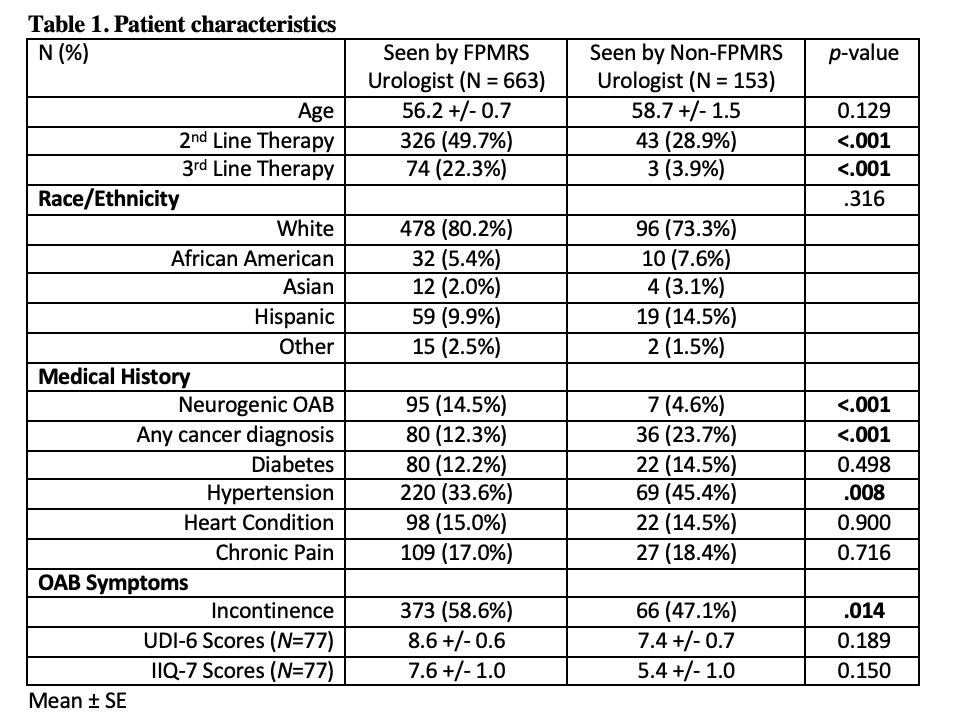Back
Introduction: Overactive bladder (OAB) is a disease entity that greatly affects a patient’s quality of life, with some studies citing a prevalence as high as 40% in the United States. The American Urological Association and Society of Urodynamics, Female Pelvic Medicine & Urogenital Reconstruction describe a progressive management of OAB from first to third line therapies (second line being pharmacotherapy and third line being procedural intervention). The objective of this study is to expand on the differences in utilization of non-first line therapy for OAB between Female Pelvic Medicine and Reconstructive Surgery (FPMRS) trained urologists and non-FPMRS trained urologists.
Methods: We reviewed the records of all adult female patients seen in our urology clinic for OAB symptoms from July 2020 to June 2021. Patients were classified into two groups: (1) those who were first seen by an FPMRS-trained urologist and (2) those who were not. Patient demographics, relevant clinical history, and choice of OAB therapy were also collected from the electronic medical record. Chi-squared tests, t-tests and univariate logistic regression were used to compare the characteristics of patients who were and were not seen by FPMRS-trained urologists.
Results: Eight hundred sixteen patients were included in this study, of which six hundred sixty three patients (81.3%) were first seen by a FPMRS-trained urologist. No demographic differences were found between the two groups. There were significantly more patients that proceeded to both second (OR 2.44, CI 1.66-3.58, p < 0.001) and third-line therapy (OR 6.98, CI 2.14-22.79, p < 0.001) within a year when they were first seen by FPMRS-trained providers. More patients that were first seen by FPMRS-trained providers also had incontinence more often than those seen by non-FPMRS trained urologists (Table 1).
Conclusions: Patients that were first seen by FPMRS urologists were 2 times more likely to proceed to second-line therapy and nearly 7 times more likely to proceed to third-line therapy for OAB within a year when compared to those seen by their non-FPMRS-trained counterparts. This finding suggests that non-FPMRS trained urologists may be providing suboptimal treatment of OAB and necessitates further study. SOURCE OF
Funding: None.

Podium Session
Session: PD33: Urodynamics/Lower Urinary Tract Dysfunction/Female Pelvic Medicine: Non-neurogenic Voiding Dysfunction II
PD33-07: Differences in Utilization of Non-First-Line Therapy for Overactive Bladder among FPMRS and Non-FPMRS Trained Urologists
Sunday, April 30, 2023
2:00 PM – 2:10 PM CST
Location: S501C
- AH
Podium Presenter(s)
Introduction: Overactive bladder (OAB) is a disease entity that greatly affects a patient’s quality of life, with some studies citing a prevalence as high as 40% in the United States. The American Urological Association and Society of Urodynamics, Female Pelvic Medicine & Urogenital Reconstruction describe a progressive management of OAB from first to third line therapies (second line being pharmacotherapy and third line being procedural intervention). The objective of this study is to expand on the differences in utilization of non-first line therapy for OAB between Female Pelvic Medicine and Reconstructive Surgery (FPMRS) trained urologists and non-FPMRS trained urologists.
Methods: We reviewed the records of all adult female patients seen in our urology clinic for OAB symptoms from July 2020 to June 2021. Patients were classified into two groups: (1) those who were first seen by an FPMRS-trained urologist and (2) those who were not. Patient demographics, relevant clinical history, and choice of OAB therapy were also collected from the electronic medical record. Chi-squared tests, t-tests and univariate logistic regression were used to compare the characteristics of patients who were and were not seen by FPMRS-trained urologists.
Results: Eight hundred sixteen patients were included in this study, of which six hundred sixty three patients (81.3%) were first seen by a FPMRS-trained urologist. No demographic differences were found between the two groups. There were significantly more patients that proceeded to both second (OR 2.44, CI 1.66-3.58, p < 0.001) and third-line therapy (OR 6.98, CI 2.14-22.79, p < 0.001) within a year when they were first seen by FPMRS-trained providers. More patients that were first seen by FPMRS-trained providers also had incontinence more often than those seen by non-FPMRS trained urologists (Table 1).
Conclusions: Patients that were first seen by FPMRS urologists were 2 times more likely to proceed to second-line therapy and nearly 7 times more likely to proceed to third-line therapy for OAB within a year when compared to those seen by their non-FPMRS-trained counterparts. This finding suggests that non-FPMRS trained urologists may be providing suboptimal treatment of OAB and necessitates further study. SOURCE OF
Funding: None.

